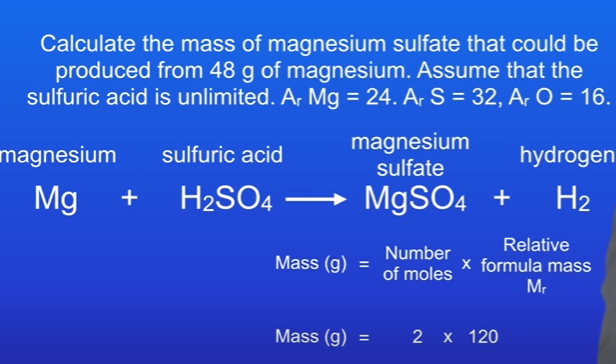Calculalting percentage yield 1
1/4
Earn XP
Description and Tags
https://www.youtube.com/watch?v=9EV0Oq8g708&list=PL9IouNCPbCxUhxxFUbR4SNfwmaRB8mYX3&index=17&ab_channel=Freesciencelessons
Name | Mastery | Learn | Test | Matching | Spaced |
|---|
No study sessions yet.
5 Terms
Calculate the mass of magnesium sulfate that could be produced from 48g of magnesium. Assume that the sulfuric acid is unlimited.
1 mole of magnesium produces 1 mole of magnesium sulfate
Work out amount of moles for magnesium by doing mass / Ar , 48/24 = 2
2 moles of magnesium can produce 2 moles of magnesium sulfate.
So to work out mass of magnesium sulfate, we do moles x Mr, 2× 120 which is 240g.
Starting mass is 48g, final mass is 240g.
This is called 100% yield, For that to happen, every single atom of magnesium must react to produce magnesium sulfate

Why is it not always possible to achieve a 100% yield.
Some of the product may be lost when its separated from the reaction mixture.
Some of the reactants may react in different ways to the expected reaction so we do not get the product we expect.
Reversible reactions may not go to completion.
How do we calculate percentage yield
Mass of product actually made / max theoretical mass of product x 100
A scientist reacted 48g of magnesium and produced 150g of magnesium sulfate. Caclulate the percentage yield.
Percentage yield = 15 /240 × 100
= 62.5%
Whats a problem students encounter
They switch the calculation, double check answer, percentage yield cannot be greater than 100% yield.